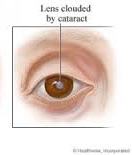Several people have asked me about their cataracts recently, and whether my work as a natural vision teacher could help them. A cataract is a clouding of the crystalline lens of the eye. The lens is formed of many fine layers of normally clear flexible material. It bulges to a more rounded shape when looking up close, then flattens when looking farther away. When I read Dr. Bates’ classic book for the first time many years ago, his story of the fish made a huge impression on me. He squeezed a living fish eye with his fingers and saw the lens become visibly cloudy from the strain! Then he relaxed the pressure, and the lens became clear again. The book includes a grainy black and white photo. I was completely convinced by this: straining the lens of the eye causes cataracts. QED! (QED is Latin for “quod erat demonstrandum”, meaning “Thus it is proven” and is used in mathematical proofs. I was a math major in college.)
Dr. Bates has written about patients whose cataracts lessened or disappeared with his relaxation therapy, and modern vision teachers have seen this as well. It stands to reason that if strain causes a problem, removing the strain will let the problem start to heal. So standard Bates techniques like palming or the Long Swing will likely be a big help to relieving the strain leading to cataracts, as will discarding too-strong glasses.
Vitamin C supplementation has been suggested for supporting cataract healing, with some vitamin C-rich eye drops being sold for this purpose. The concentration of vitamin C in the lens of the eye is higher than anywhere else in the human body. Since vitamin C is eaten up by stress, during periods of illness or unusual pressure in your life you might want to take a little extra.
Colorado vision teacher Greg Marsh gives this lens flexibility visualization exercise. Close your eyes and relax, taking a deep slow breath to settle yourself. As you breathe in again, imagine your lens swelling up and getting fatter while you think of looking at something close. As you slowly exhale and think of looking farther away from you, imagine your lens getting flatter. Breathe in, look close, lens fattens; breathe out, look far, lens flattens. This should be gentle and peaceful, like gills moving on a fish. See your lenses as moist and flexible throughout this.
If you do opt for cataract replacement surgery, be aware that this is the most common surgery performed in the US, pretty much tried and true. Originally lenses from a cadaver (dead person) were used. Now replacement lenses are plastic, and unfortunately often come with a prescription. To me this is like wearing glasses which you can’t remove, giving your natural vision no room to improve on its own. The eye doctor may think he is helping you by recommending this, but I’d be cautious, and choose clear (no prescription) replacement lenses if you have to go this route. If the prescription isn’t perfect or is too strong, you can’t remove it.
For anyone who is worried about cataracts, I’d suggest visualizing your lenses as flexible and fluid, easily taking in nutrients and releasing waste, breathing in and out like little pearl onions in the Greg Marsh exercise above. The body believes these mental images, so I’d rather have you see your lens as moist and healthy than “as hard as stone” which some people’s eye doctors have told them! One of my teachers calls this a “medical hex”, and unfortunately we often take to heart such negative messages.
It’s so much more life-affirming and health-affirming to see yourself as vibrant and clear-sighted! I tell my clients to put that positive picture out there in front of them, like a dream they want to come true, then walk into it, making it their reality.
get help on our Facebook Group!
I wore strong glasses, then contact lenses, from age 5 into my 40s. While making many mistakes, eventually l learned how to improve the way I use my eyes and to see in a more relaxed, healthy manner. It is my pleasure to coach others to do the same. Visit me at https://NancyLNeff.com.
